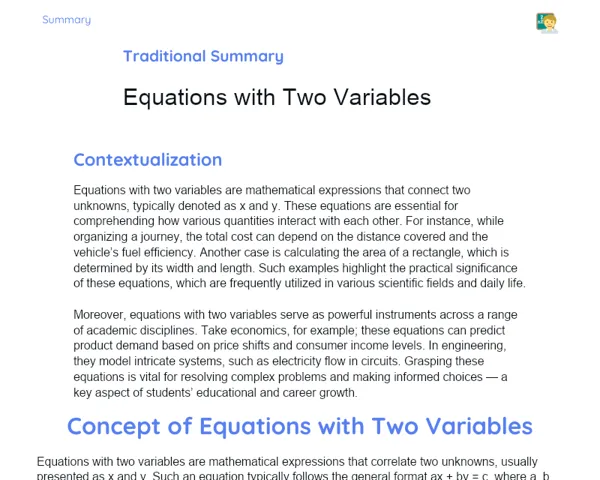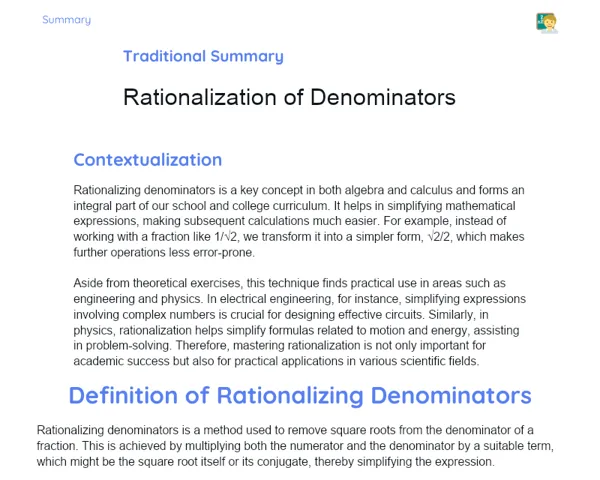Objectives
1. Understand what a sample survey is and how it differs from a census survey.
2. Develop skills to extract and analyze information from sample surveys, including the use of measures of central tendency such as mean, mode, and median.
Contextualization
Did you know that sample surveys are integral to the decisions that impact our everyday lives, from predicting election results to designing new products? For instance, Netflix utilizes sample surveys to gauge which shows to make based on the preferences of a subset of its subscribers. This highlights how an understanding of statistics can empower us in various sectors, aiding in behavior prediction and informed decision-making.
Important Topics
Sample Surveys vs. Census Surveys
Sample and census surveys are key methods for collecting statistical data. A census survey aims to gather data from every individual in a population, while a sample survey involves data collection from a select group representing the population. The choice between these two methods hinges on resource availability, time constraints, and the desired accuracy level.
-
Census surveys are often seen as more accurate but tend to be pricier and more time-intensive, especially with large populations.
-
Sample surveys are more cost-effective and quicker but rely heavily on how representative the sample is.
-
Statistical methods are essential for drawing conclusions from the sample to the larger population, and inaccuracies can arise if not executed properly.
Measures of Central Tendency
Measures of central tendency are statistics that signify the center point of a dataset. The three most common are the mean, mode, and median. The selection of the most suitable measure depends on the data's distribution and the analysis's objective. For example, while the mean is influenced by extreme values, the median offers a sturdier option in such cases.
-
The mean is calculated by summing all values and dividing by the number of observations, commonly used for symmetrical data.
-
The mode is the most frequently occurring value, making it beneficial for categorical data or in instances with multiple modes.
-
The median is the middle value in an ordered dataset and is less swayed by extreme values, rendering it useful in skewed distributions.
Sample Representativeness
A sample's representativeness is crucial for the conclusions of a sample survey to hold relevance for the broader population. A sample must reflect the significant characteristics of the studied population, necessitating proper sampling techniques and an adequate sample size.
-
Random selection is a common method to guarantee that every member of the population has an equal opportunity to be included in the sample.
-
The sample size should be sufficiently large to minimize sampling error, which indicates the variance between the sample statistic and the whole population.
-
Stratification, or dividing the population into consistent subgroups, can enhance the sample's representativeness, especially in diverse populations.
Key Terms
-
Sample Survey: A data collection method that selects a representative subset from a population to make inferences about that larger group.
-
Census Survey: A data collection approach that gathers information from every member of a population.
-
Mean: A measure of central tendency computed as the total of all values divided by the count of observations.
-
Mode: The value that appears most frequently in a dataset.
-
Median: The value that sits in the middle of an ordered dataset, dividing the data into two equal halves.
For Reflection
-
How does the distinction between a sample survey and a census survey impact the accuracy of study conclusions?
-
Why is it essential to consider the data's distribution when selecting a measure of central tendency?
-
What are the practical challenges in ensuring a sample truly represents a larger population?
Important Conclusions
-
Today, we delved into the intriguing realm of sample surveys and their significance in guiding informed decisions across various sectors, including marketing and governance.
-
We examined the differences between sample and census surveys, the importance of representativeness in samples, and how measures of central tendency can be utilized to extract insights from data.
-
We acknowledged that the choice of sample and appropriate data analysis are vital to avoid misinterpretations and uphold the reliability of our conclusions.
To Exercise Knowledge
- Create a brief questionnaire to gather data from your family regarding their movie or food preferences. Implement the questionnaire and calculate the mean, mode, and median from the responses. 2. Draft a short report discussing how varying measures of central tendency influence the interpretation of results. 3. Based on the gathered data, predict which types of movies or foods are likely to be most popular in your locality.
Challenge
🚀 Statistical Detective Challenge: Picture yourself as a detective aiming to uncover the most popular dish at a new restaurant in town. Use sample surveys to chat with locals and determine what the most favored dish is. Present your findings and justify why you believe your result accurately represents the community's preferences!
Study Tips
-
Utilize spreadsheet tools like Excel or Google Sheets to practice calculating mean, mode, and median using sample datasets. This will help you visualize and grasp statistical concepts more firmly.
-
Keep an eye on news articles that utilize sample surveys, and try to analyze how the data was collected and processed. This will help you appreciate the practical applications of the statistical methods we've discussed.
-
Consider joining online forums or study groups to engage in discussions and share insights on different data collection techniques and statistical analyses with peers. Exchanging ideas can enhance your understanding and abilities in this subject.



